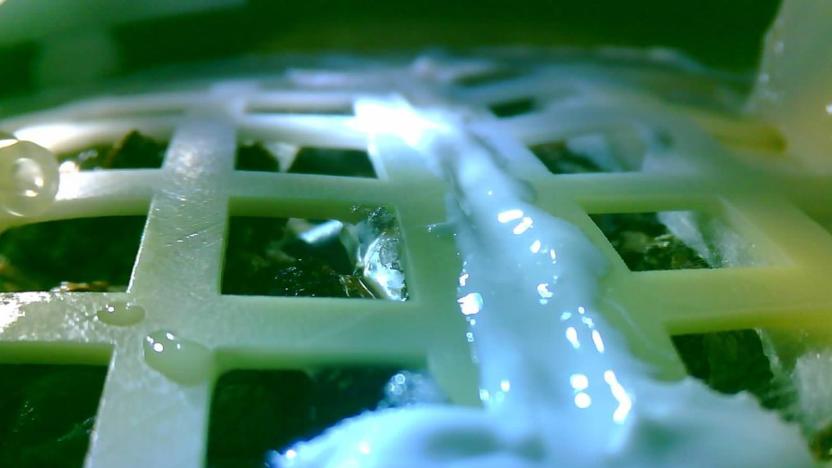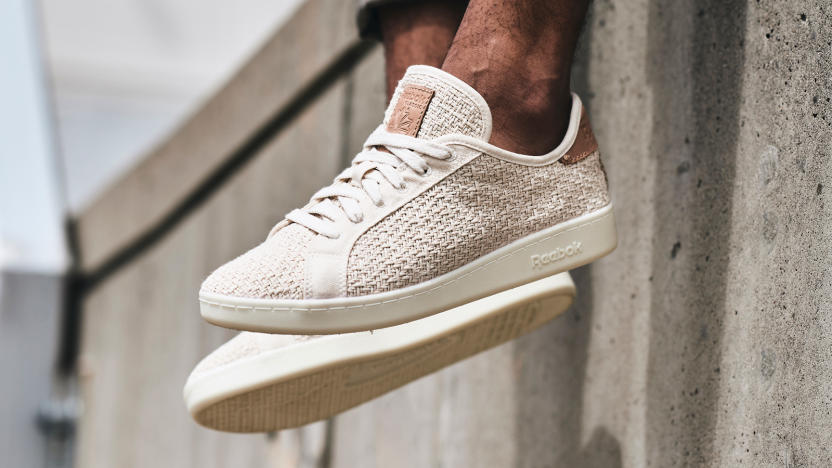cotton
Latest

China grows the first plants on the Moon
The greenery you see in the soil above might not look like much, but it represents a big step in space exploration. Cotton seeds brought to the Moon aboard China's Chang'e-4 mission have sprouted, marking the first time plants have grown on the lunar surface. They're not in contact with the lunar surface, as you might imagine. The cotton, potato seeds, yeast and fruit fly eggs are instead tucked inside a sealed, self-sustained biosphere that provides the necessary climate and nourishment.

Reebok's first plant-based shoes go on sale for $95
It took a while, but Reebok's first plant-based shoes are ready for your feet -- the company is now selling limited numbers of the NPC UK Cotton + Corn through its website for $95 a pair in unisex sizes. You'll have to be happy with a lone "natural/chalk" color combo, but you can feel better knowing that 75 percent of the shoe is made from USDA-certified biological material. The upper is made entirely of the shoe's namesake cotton, while the sole is made from a corn-derived biobased TPU (DuPont's Susterra Propanediol). Even the insole is made from castor bean oil, and Reebok avoids using dyes to maintain the shoe's eco-friendly credentials.

Reebok will introduce plant-based sustainable shoes this year
While others try shoes that lace themselves or have 3D printed soles, Reebok will have "plant-based" footwear on shelves this year. Adidas already sold a sneaker produced from ocean-plastic, but Reebok's "Cotton + Corn" push is focused on shoes that are made from sustainable, growing materials, that can even be used as compost after they're worn out.

Cotton-polymer material absorbs or repels moisture depending how hot it is
Aside from the sweltering daytime heat and the freezing night-time temperatures, the biggest problem for folks living in desert regions is finding sources of water. Researchers from Eindhoven University of Technology and Hong Kong Polytechnic have leveraged those temperature swings to help solve the arid region hydration conundrum with a cotton material that absorbs water straight from the surrounding air. Of course, it's not your run-of-the-mill fabric woven from fluffy white stuff. This cloth is coated in a special polymer, called PNIPAAm, that's hydrophilic (read: super absorbent) at temperatures 34°C and below, but becomes hydrophobic (read: repels water) when it gets any hotter. In absorption mode, the cloth can hold 340 percent of its own weight -- compared to just 18 percent without the polymer's aid -- and when it warms up, it releases the collected moisture as clean and pure potable water. So, it can help hydrate both plants and people in desert regions around the world. The boffins who created the stuff claim it's reusable and can be used on locally-sourced cotton fabrics for a minimal, 12 percent cost increase given current manufacturing conditions. Not impressed? Well, the magical moisture-absorbing material may get even better, as the plan is to increase the amount of water the material can hold and lower the temperature threshold for its release.

The touch, the feel of cotton, the fabric of our... transistors
Transistors of all shapes and sizes form the foundation of just about every electronic gadget under the sun, and similarly, cotton clothing is a key component of a well-rounded wardrobe. It was only a matter of time before these two got together to form a fashion-forward future, and an international team of scientists have accomplished the trick by creating a transistor using fibers of cotton. Now, this isn't the first organic transistor, but cotton's plentiful, cheap, lightweight and sustainable nature make it a great choice for use as a substrate in carbon-based transistors. To get the fluffy white stuff ready to amplify and switch electric signals, it was conformally coated (to cover all the fiber's irregularities) with gold nanoparticles, semiconductive and conductive polymers in a super thin layer to preserve its wearability flexibility. The result was an active transistor that can be used in integrated circuits sewn into your shirt, socks, or even pantaloons, if you like. The future of fashion is right around the corner, folks, and in that future your pants are the PC.

Conductive nanocoating could lead to flexible, wearable devices, Lady Gaga sticks with meat suit
Flexible is the new rigid in the gadget world, from OLED panels and e-paper displays to, of course, the adorable PaperPhone. Now researchers at North Carolina State University are hoping to take flexible to the next level by applying a conductive nanocoating – thousands of times thinner than a human hair – to ordinary textiles. Their technique, called atomic layer deposition, grows an inorganic coating atop cloths like woven cotton. The treated fabric conducts electricity, opening the door to thin, wearable devices with the flexibility of everyday clothing. The technology's still in its nano-infancy, but who knows: maybe a few years from now you'll be sporting a genuinely playable Angry Birds shirt.

Zen master Zimoun asks: what is the sound of 138 motorized cotton balls rolling on cardboard? (video)
Unlike most of us, Zimoun sees a pile of DC motors, cotton balls, and cardboard boxes and thinks "I can work with this." That, along with his mysterious single name, is what makes him an artist. We're all fans of gadget-centric art -- especially when it involves fire or seemingly worthless parts -- and the Swiss sculptor certainly loves the latter. His installations feature dozens of motorized cotton balls rolling across cardboard; the result sounds something like a heavy rainstorm. Or like the incessant, deadly chewing of the Langoliers, depending on your point of reference. Check the video after the break to decide for yourself.

'Wipe Shirt' disregards mother, encourages you to wipe gadgets on your sleeve
The simplicity of a white dress shirt crafted of pure cotton meets the gadget-cleansing power of microfiber in this "Wipe Shirt" from husband-and-wife design team FIFT. Because you've gotta wear something with that solar tie and swine-flu resistant suit, and you might as well fight smartphone cheek syndrome (and all other manner of glossy gadget smudging) while you're at it. Yours for ¥13,650 (or about $150) in either the microfiber cuff or shirttail variant, only from Japan.

AAPL touches 52-week low, closes under $100
Apple shares today reached their lowest price point since April 2007, closing at 97.07, down 3.03 points. AAPL hit its 52-week low today, $94.65 per share, around 3:45 PM Eastern. Early in the day, the stock was jarred with false rumors from CNN's iReport service about Steve Jobs suffering a heart attack. TUAW's own Michael Rose was among the first to contact Apple's PR VP, Katie Cotton, who said the rumors were untrue. After the scare, prices rebounded, but never reached their highs for the day just before the rumor bubbled to the surface. Volume was at its heaviest before 10 a.m. Eastern, with about 16 million shares changing hands. In sum total, 82 million shares were traded over the course of the day. Apple shares were slightly ahead in early after-hours trading.

Real-life Mooncloth Bag (and Horde earrings)
Yup, it's a real-life Mooncloth Bag. SpikeHeadDesign over on Etsy has turned the 16-slotter's icon into an actual, real-life bag. Instead of actual Mooncloth, though (there are no real Moonwells on Earth, unfortunately), it's made of corduroy, cotton, a few buttons and velcro, and some kind of lace on the side (though I know my Shaman would never actually use something with lace on it, so they must all be different). Looks terrific, anyway, and it should for that price: $180.00. Still, for a handmade, one-of-a-kind bag, can't go wrong. The creator says that Netherweave is next, and it'll be exciting when we get to "Gigantique."Alice Taylor of the great Wonderland blog has also been dutifully keeping up with WoW stuff on Etsy: she found these great Horde earrings that have unfortunately sold out (though this other design is still available). Could be the perfect gift for the jewelry-adorned WoW player in your life.Thanks, Jaynnie!



